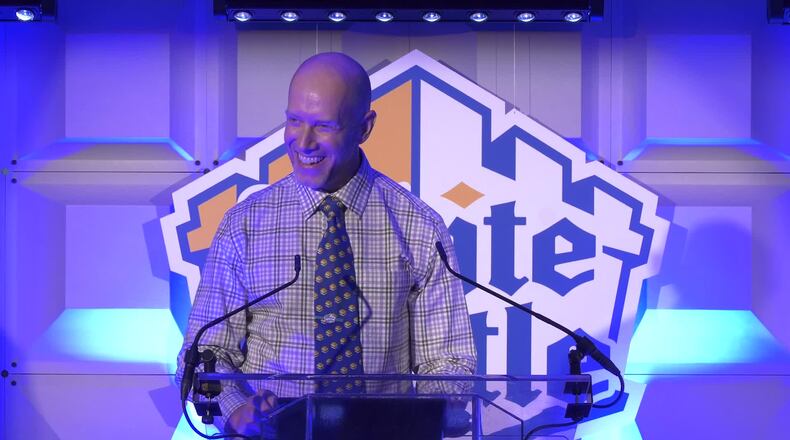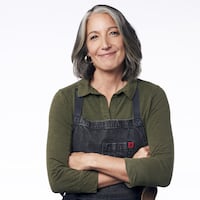Some Southerners might say that folks raised in other regions don’t fully grasp the allure of Chick-fil-A, or why the yellow glow of Waffle House at 2 a.m. is a beacon of hope for a sloshed soul.
I’d argue that Ohio-based White Castle — the first hamburger fast-food chain in the world — holds a similar charm for many a Midwesterner.
It takes a fellow like Ken Oberle of Marietta, newly inducted into the White Castle Cravers Hall of Fame, to proselytize to the good people in these parts about the virtues of the 100-year-old burger chain that is so familiar to those from flyover country.
Oberle, 52, adores White Castle so much that he proposed to his wife, Elena, in 2003 with one of the restaurant’s chicken rings serving as a proxy symbol of their betrothal (until they settled on the real ring her heart desired).
Credit: contributed
Credit: contributed
Because Georgia is a White Castle desert (it’s the home of the separately owned Krystal chain, which has a similar square burger), Oberle has made it his mission to preach the gospel of the Original Slider to the couple’s 11-year-old twin sons, Ethan and Luke, and to his co-workers at Kennestone Hospital, where he works as a radiographer.
Oberle’s affinity for belly bombers began at a young age, in his hometown of St. Louis. His family of seven didn’t eat out often. So, when Oberle’s dad brought home White Castle — boy, was that a treat!
Credit: contributed
Credit: contributed
When he was old enough to get a job, Oberle applied at White Castle. The high schooler swept the floor, wiped down the stainless steel fixtures and restocked shelves. He learned the art of cooking miniature square beef patties punched with five holes, cooking onions, grabbing a pickle and sandwiching it all inside a fluffy bun. He also took full advantage of the all-you-can-eat-for-free-while-on-the-clock benefits: “Every time I’d eat, I’d have $10 worth. That’s like $30 worth today,” he said.
He continued to sling sliders through college — and even after he’d earned his degree. Oberle worked at White Castle for a whopping 17 years. He was on the payroll in the 1990s, when the company began offering full-service, sit-down meals — complete with tablecloths, china and candles — on Valentine’s Day. He worked at so many locations that, even now — nearly 20 years after moving to metro Atlanta — whenever he stops at a White Castle during visits to St. Louis, he runs into an employee he knows.
White Castle is not just a Ken thing, either. It’s an Oberle family thing.
His grandparents jotted down their bridge scores on White Castle-branded pads.
Credit: contributed
Credit: contributed
His mother’s White Castle stuffing was a Thanksgiving tradition. In 2012, when he stepped off the plane to visit her for the last time before she lost a battle with cancer, he grabbed a sack from White Castle so they could share one final belly bomber moment.
Whenever his siblings eat at White Castle, they text him photos. “It’s a little bit of a tease, but also embracing the family bond around the Castles,” he said.
Credit: Contributed
Credit: Contributed
Oberle continues to feel a kinship with his former employer, too.
“I would equate it with Chick-fil-A. Everybody knows the Ingrams, the family that is running it. It’s more of a caring, family-oriented business than a franchised fast-food place,” he said. “The food is more Krystal-like; the environment around it is more like Chick-fil-A.”
There’s data to support that statement: One in four White Castle team members spend at least 10 years working for the company.
Credit: contributed
Credit: contributed
Securing a place in the White Castle Craver Hall of Fame isn’t limited to employees. Anyone can enter the contest by completing a form that expresses their passion for the brand and the ways in which the restaurant has impacted their lives. Since the club’s inception in 2001, 272 Cravers have been inducted.
Oberle put his name in the hat for the class of 2021 when he realized that year marked the company’s 100th anniversary. What’s more, winning would mean a trip to White Castle headquarters in Columbus, Ohio, where the self-professed history buff could check out artefacts dating back to the company’s origins in Wichita, Kansas, and its founders, Billy Ingram and Walter Anderson.
Credit: contributed
Credit: contributed
The company has been an innovator in the food-service industry ever since Ingram had the bright idea of selling 5-cent burgers by the sack. It marked the birth of carryout, the advent of a hamburger fast-food chain and put burgers on a course to be a defining element of American cuisine.
“People had eaten hamburger meat before, but, at the time, it was thought of as not very family-oriented. It was something that factory workers might eat,” Oberle said. “But, they were the ones to convince people. That’s why they have all the grills in sight ... so people could see it was actual meat, and it was safe. White Castle had an uphill battle to prove the hamburger could be edible.”
Oberle also is impressed by the company’s many other firsts. “The first industrial spatula was when Billy Ingram welded a screwdriver handle to a sawblade,” he said. “They came up with the (employee) paper hats and invented the machine that makes those. They built their own stainless-steel equipment, because there was no infrastructure in the industry yet.”
If you want to dive deeper, Oberle recommended picking up a copy of “Selling ‘Em By the Sack: White Castle and the Creation of American Food” by David Hogan (NYU Press, 1999).
Credit: contributed
Credit: contributed
White Castle is keeping up with the times, too. In 2018, it was the first fast-food chain to launch the Impossible Slider.
A plant-based slider, however, is not Oberle’s standard order. He prefers a double jalapeno cheese with extra onion and pickle. And, he recommends trying the new 1921 slider, which he called “a throwback to the original ones, where they smashed the meat onto the griddle. This new one is thicker, not the usual flat (patty) with the five holes. It’s more like a small slider regular hamburger, with lettuce and tomatoes.”
From time to time, Oberle purchases the frozen sliders sold in grocery stores, but he said it’s not the same as a full-fledged, in-person White Castle experience.
Credit: handout
Credit: handout
He hasn’t gone to extremes like fellow 2021 Craver Hall of Fame inductee Scott Kempf of California, who visited 165 White Castles in a span of 21 days. But, Oberle has driven to Murfreesboro, Tennessee, for the sole purpose of eating at White Castle. That unit since has closed, making Nashville the nearest city where he can get his fix. “But, now there is one in Orlando,” he said, “so I might have to trek down that way.”
The craving is a powerful thing.
About the Author
The Latest
Featured









